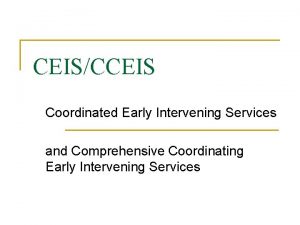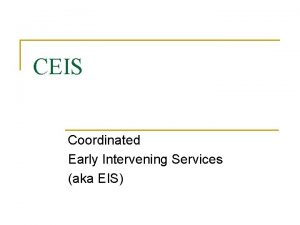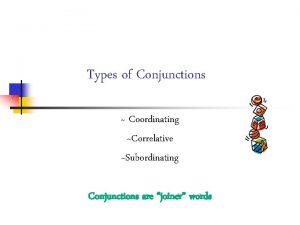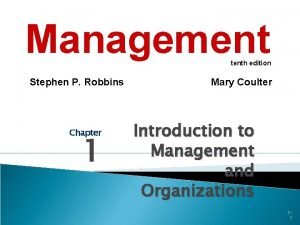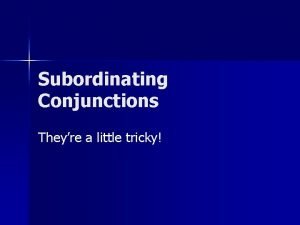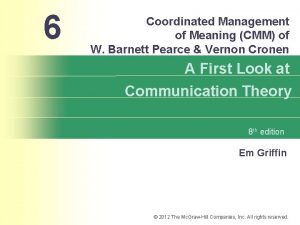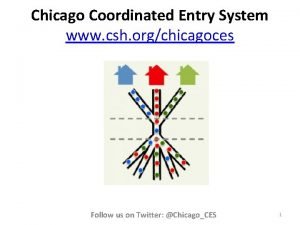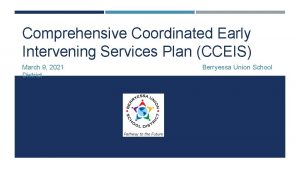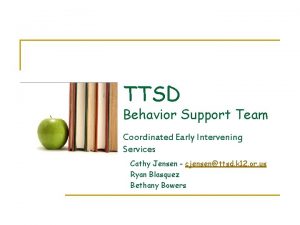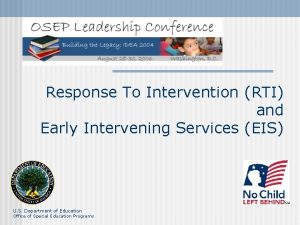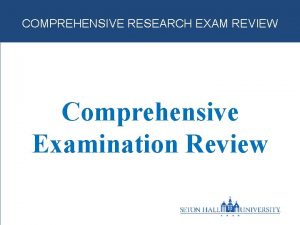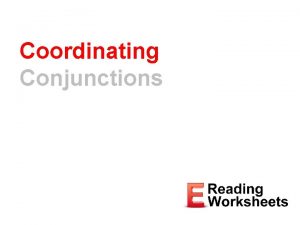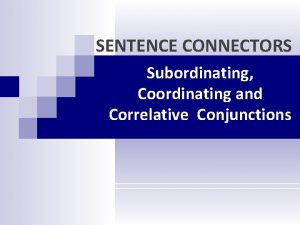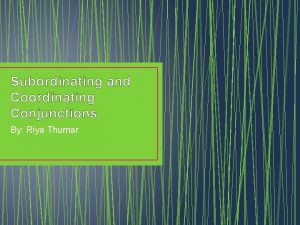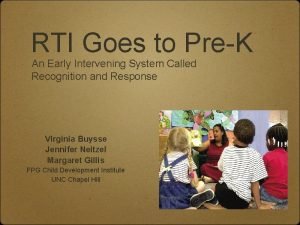CEISCCEIS Coordinated Early Intervening Services and Comprehensive Coordinating






![CEIS Activities Defined by Regulations [34 CFR 300. 226(b)] [20 U. S. C. 1413(f)(2)] CEIS Activities Defined by Regulations [34 CFR 300. 226(b)] [20 U. S. C. 1413(f)(2)]](https://slidetodoc.com/presentation_image/0af6f3293d47a871c27137fbec3d5f3a/image-7.jpg)
















- Slides: 23

CEIS/CCEIS Coordinated Early Intervening Services and Comprehensive Coordinating Early Intervening Services

CEIS vs Comprehensive CEIS – What’s new with the reserve? CEIS n n n Comprehensive CEIS or CCEIS Voluntary reserve Not significantly disproportionate Children in K-12 Children without disabilities/IEPs Must track and report students who receive the services n n n Required reserve Identified with significant disproportionality in identification, placement, and/or discipline Children ages 3 up through grade 12 Children with or without IEPs but not exclusively children with disabilities Must track and report students who receive the services

Comprehensive CEIS (CCEIS) Defined by Regulations A broad range of activities that include: Ø Ø Ø professional development and educational and behavioral evaluations, services, and supports, e. g. functional behavioral assessments, behavioral interventions plans, and positive behavioral interventions and supports. ADDRESSING FACTORS leading to disproportionality Ø Examples: Ø Lack of access to quality instruction; Ø economic, cultural, or linguistic barriers to appropriate identification or placement; Ø lack of access to screenings.

Comprehensive CEIS (CCEIS) Defined by Regulations n n As part of implementing comprehensive CEIS, an LEA must identify and address the factors contributing to the significant disproportionality. (81 FR 243, pg. 92378) New § 300. 646(d)(1)(iii), requires an LEA, in implementing comprehensive CEIS, to address any policy, practice, or procedure it identifies as contributing to significant disproportionality, including any policy, practice or procedure that results in a failure to identify, or the inappropriate identification of, a racial or ethnic group (or groups). (81 FR 243, pg. 92378) The LEA has discretion as to how to address the policy, practice, or procedure, including by eliminating, revising or changing how it is implemented, as long as it does so in a manner consistent with the requirements of the IDEA and its implementing regulations. (See 34 C. F. R. § 300. 646(d)(1)(iii). ) New § 300. 646(e) clarifies that LEAs that serve only children with disabilities are not required to reserve IDEA Part B funds for comprehensive CEIS. (81 FR 243, pg. 92378)

Comprehensive CEIS (CCEIS) Amended§ 300. 646(b) (2) (new § 300. 646(d)) Who may receive Comprehensive CEIS (when an LEA has been identified with significant disproportionality)? n n n Ø Children from age 3 through grade 12, regardless of whether they are children with disabilities, and, May not serve only children with disabilities The LEA may distribute the IDEA Part B funds reserved for comprehensive CEIS to its schools to carry out comprehensive CEIS, and the LEA retains discretion about how to allocate those funds within the LEA. As such, if an LEA determines that it is best able to address the factors contributing to the identified significant disproportionality by providing a portion of its reserved funds to a particular subset of schools for comprehensive CEIS, it is permitted to do so. In contrast, a district that voluntarily reserves CEIS may not serve children younger than Kindergarten or children with IEPs with the funds.

Comprehensive CEIS (CCEIS) Amended§ 300. 646(b) (2) (new § 300. 646(d)) Implications for IEPs n n n If comprehensive CEIS funds are used to provide services that address factors contributing to the significant disproportionality identified by the State, then the fact that those services are also identified in some children’s IEPs does not make the services impermissible or the expenditures improper. However, we generally would not expect that using comprehensive CEIS funds for the purpose of providing services already identified on a child’s IEP would address factors contributing to the significant disproportionality identified by the State. An LEA may use comprehensive CEIS funds for functional behavioral assessments and behavioral intervention plans, but only to the extent that it is doing so to address the factors identified by the LEA as contributing to the significant disproportionality identified by the State.
![CEIS Activities Defined by Regulations 34 CFR 300 226b 20 U S C 1413f2 CEIS Activities Defined by Regulations [34 CFR 300. 226(b)] [20 U. S. C. 1413(f)(2)]](https://slidetodoc.com/presentation_image/0af6f3293d47a871c27137fbec3d5f3a/image-7.jpg)
CEIS Activities Defined by Regulations [34 CFR 300. 226(b)] [20 U. S. C. 1413(f)(2)] n Professional development for teachers and other n n school staff to enable such personnel to deliver scientifically based academic and behavioral interventions, including scientifically based literacy instruction, and, where appropriate, instruction on the use of adaptive and instructional software; and Providing educational and behavioral evaluations, services, and supports, including scientifically based literacy instruction. When district voluntarily reserve EIS funds

CEIS Guidance Who may receive CEIS - a voluntary reserve? n n n Children who are not yet in kindergarten may not receive CEIS. Children with IEPs may not receive CEIS An LEA determines which students need additional support. q q For example, an LEA might consider factors such as performance on reading or math assessments, disciplinary referrals, or suspension and expulsions. If an LEA chooses to use CEIS funds to support school-wide interventions, it must be able to provide documentation that CEIS funds were used to provide services only to students in need of additional support and that other funds were used to fund the school-wide intervention for special education students and students who do not need additional support.

CEIS Guidance How should an LEA count and track students who received CEIS when funds are used for professional development or a school-wide intervention initiative? n n n It would be appropriate for an LEA to count, and subsequently track for two years, the number of students in need of additional support who received instruction from personnel who participated in the professional development program. It would not be appropriate to count every student who was taught by these personnel if some of the students were not in need of additional support or were receiving special education services. An LEA should only count the students and the personnel who participated in the professional development program in the year(s) of or the year(s) immediately after the training, rather than counting the students and those personnel each year after the training.

CEIS Guidance How should an LEA count and track students who received CEIS when funds are used to provide behavioral and educational evaluations? n n n LEAs may use CEIS funds to provide behavioral and educational evaluations to determine the supports that are needed by students to succeed in a general education environment. However, funds may not be used for evaluations that are intended for use in determining eligibility for special education and related services. Students who are evaluated to determine the supports necessary for success in a general education environment should be counted as receiving CEIS in the year of or the year immediately following the evaluation and tracked for the following two years.

CEIS Guidance How may CEIS funds be used to implement RTI/MTSS? n CEIS funds may be used to support RTI/MTSS as long as the CEIS funds are used for services to nondisabled students in need of additional academic or behavioral support and supplement, not supplant, other funds used to implement RTI/MTSS.

CEIS Guidance What are the supplement not supplant requirements for CEIS funds? n Must be used to supplement State, local, and other Federal funds and not to supplant those funds. This requirement applies to all Part B funds including any used for CEIS. n In addition, 34 CFR § 300. 226(e) states that CEIS funds may be used to carry out CEIS aligned with activities funded and carried out under the ESEA if those funds are used to supplement, and not supplant, funds made available under the ESEA for the activities and services assisted using CEIS funds.

Questions and Answers On Early Intervening Services (EIS) n Question E-3: What services can be defined as early intervening services? For example, are physical therapy, occupational therapy, and assistive technology considered early intervening services? n Answer: Nothing in the Act or regulations prevents States and LEAs from including related services personnel in the development and delivery of educational and behavioral evaluations, services, and supports for teachers and other school staff to enable them to deliver coordinated, early intervening services.

Question F-5 on RTI (http: //idea. ed. gov/explore/view/p/, root, dynamic, Qa. Corner, 8, . html ) n n An RTI model with a three-tier continuum of school-wide support might include the following tiers and levels of support: (1) Tier one (Primary Intervention), for all students using high quality scientific research-based instruction in their general education setting. It would not be appropriate to use EIS funds for these activities since these students do not need additional academic and behavioral support to succeed in a general education environment. (2) Tier two (Secondary Intervention), for specialized small group instruction of students determined to be at risk for academic and behavioral problems. It would be appropriate to use EIS funds to support these activities. (3) Tier three (Tertiary Intervention) for specialized individualized instructional/behavioral support for students with intensive needs. EIS funds could be used for children without disabilities unless the district is required to reserve CCEIS and can then include children with disabilities.

e. RIDE Data Collection Program names: Program description Individual Student File Upload n n n Intervention - behavior/social emotional: Interventions provided to general education students to address behavioral and/or social emotional needs (can include social skills, behavior management, counseling, etc. ) Intervention – math: Interventions provided to general education students to improve and support math skills Intervention – reading: Interventions provided to general education students to improve and support reading skills Intervention - oral language: Interventions provided to general education students to improve and support oral language skills (can include articulation, pragmatic language, etc. ) Intervention – writing: Interventions provided to general education students to improve and support writing skills Intervention - other academic: Interventions provided to general education students to improve and support other academic skills besides math, reading, oral language, writing (can include general education students who receive instruction from staff specially trained with EIS funds within one year from the date of training)

Program codes

Collection format for CCEIS/CEIS LAST SASID LASID DISTCODE NAME PROGRAM CODE PROGRAM SDATE PROGRAM EDATE PROGRAM_EXIT CODE Ø EIS are not intended to serve the same children for years as a proxy for special education. Ø Please do not project end dates several years down the road. Ø Include RTI/MTSS Tier 2 or 3 interventions funded with CEIS or CCEIS. Ø Do not include any RTI/MTSS interventions funded with Title I or local or other dollars besides CEIS/CCEIS. Ø This is not a PLP collection.

How do I know what we are tracking? n n District leadership would provide data managers and personnel completing the upload with the list of students who benefitted from EIS $ in IDEA. q The point person varies by district: it may be the curriculum coordinator, RTI coordinator, special education directors, literacy coordinator, etc. Open the IDEA Part B portion of Accelegrants. q Refer to the EIS Plan in related documents & q Budget pages in Part B only

Accelegrants Early Intervening Services Plan n n n n Purpose of Intervention/Training Targeted school(s) &Targeted grade level(s) Proposed # of students Description of students who will receive intervention/benefit from teachers who receive this training Targeted subject area Description of staff who will deliver intervention/receive training Entrance criteria for intervention Description of ongoing progress monitoring for students receiving intervention or benefit from teacher training Exit criteria for intervention


Students may benefit from EIS through working with teachers who have received particular training and/or materials.

Resources on disproportionality and Comprehensive CEIS n Significant Disproportionality 101 Presentation https: //www. youtube. com/watch? v=g 8 xb. Jr 9 Qru. E&feature=youtu. be This 30 minute, pre-recorded Significant Disproportionality 101 presentation provides a more detailed description of the significant disproportionality regulation. We encourage you to watch this presentation if you would like to learn about more detailed, foundational information. You can also view the Power. Point presentation for this event. n Fact Sheet: Equity in IDEA https: //www. ed. gov/news/press-releases/fact-sheet-equity-idea This fact sheet from the U. S. Department of Education provides background on the topic of significant disproportionality and summarizes the new regulations. n Dear Colleague Letter: Preventing Racial Discrimination in Special Education https: //www 2. ed. gov/about/offices/list/ocr/letters/colleague-201612 -racedisc-special-education. pdf This letter addresses the issue of significant disproportionality and provides guidance to States, districts, and schools regarding this topic. n U. S. Department of Education's Rethinking Discipline Webpage https: //www 2. ed. gov/policy/gen/guid/school-discipline/index. html This webpage links to several federal resources and guidance documents related to the issue of significant disproportionality and equitable discipline practices. n Resources on CEIS from the Center for IDEA Fiscal Reporting http: //cifr. wested. org/resources/ceis/ This page contains information on CEIS and related requirements.

Resources on disproportionality and Comprehensive CEIS n IDEA Data Center's FAQ on Navigating CEIS https: //ideadata. org/files/resources/55354 d 14140 ba 0253 f 8 b 45 b 0/5543 c 5 bc 140 ba 0346 f 8 b 45 dd/42820_idc_moe_ce is_faq_v 8 for 508/2015/05/01/42820_idc_moe_ceis_faq_v 8 for 508. pdf This document focuses on helping State Education Agencies (SEAs) and Local Education Agencies (LEAs) understand CEIS and its reporting requirements. n CEIS Guidance Document from the U. S. Department of Education https: //www 2. ed. gov/policy/speced/guid/idea/ceis_pg 3. html This document provides an overview of CEIS and offers guidance to stakeholders about how CEIS may be used to address significant disproportionality. n IDC’s Resources on Disproportionality https: //ideadata. org/resource-library/listing/? search=&indicators=all&topics=569933 ee 150 ba 0114 f 8 b 45 c 7 This page lists resources developed by IDC and IDC partners on the topic of disproportionality, including white papers, presentations, rubrics and other tools. n New York University's Technical Assistance Center on Disproportionality: Identifying the Root Causes of Disproportionality https: //steinhardt. nyu. edu/scms. Admin/media/users/ll 81/Identifying_the_Root_Causes_of_Disproportionality. pdf This resource aims to help personnel from State and district education agencies identify the root causes of disproportionality at the district level. n CEEDAR Innovation Configuration on Culturally Responsive Teaching http: //ceedar. education. ufl. edu/wp-content/uploads/2014/08/culturally-responsive. pdf This paper features an innovation configuration (IC) matrix that can guide teacher preparation professionals in the development of appropriate culturally responsive teaching (CRT) content.
 Coordinated early intervening services
Coordinated early intervening services Early intervening services
Early intervening services Sample of intervening phrases
Sample of intervening phrases What is intervening phrases
What is intervening phrases Early cpr and early defibrillation can: *
Early cpr and early defibrillation can: * Coordinated product and supply chain design
Coordinated product and supply chain design The central instrument for directing and coordinating
The central instrument for directing and coordinating Chapter 2 developing marketing strategies and plans
Chapter 2 developing marketing strategies and plans Types of conjuntions
Types of conjuntions Management involves coordinating and overseeing
Management involves coordinating and overseeing Manager privileges chapter 1
Manager privileges chapter 1 Coordinating and subordinating
Coordinating and subordinating Subordinate conjunction examples
Subordinate conjunction examples Housing and urban development coordinating council
Housing and urban development coordinating council An organization is a consciously coordinated social unit
An organization is a consciously coordinated social unit Serpentine model cmm
Serpentine model cmm 211 snohomish county
211 snohomish county Coordinated community response training
Coordinated community response training Genevieve carlson
Genevieve carlson Commonwealth coordinated care
Commonwealth coordinated care Csh chicago
Csh chicago Introduction to retail management
Introduction to retail management Coordinated effort in retailing concept
Coordinated effort in retailing concept A series of coordinated related multiple projects
A series of coordinated related multiple projects
